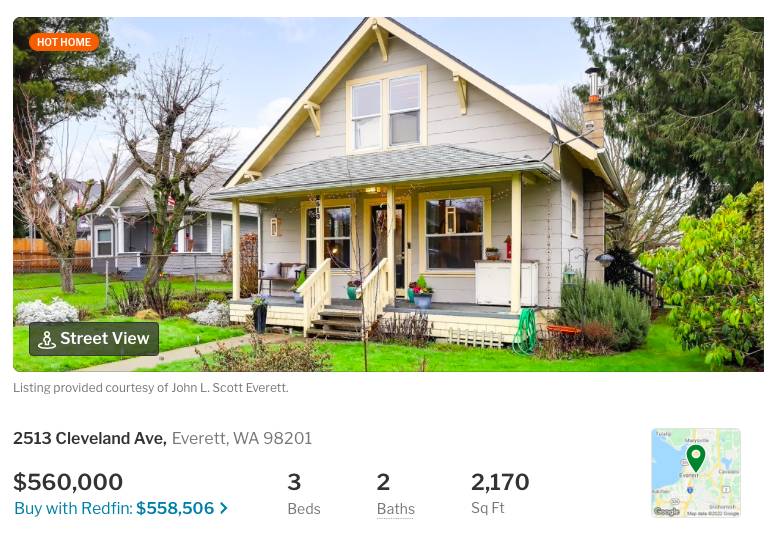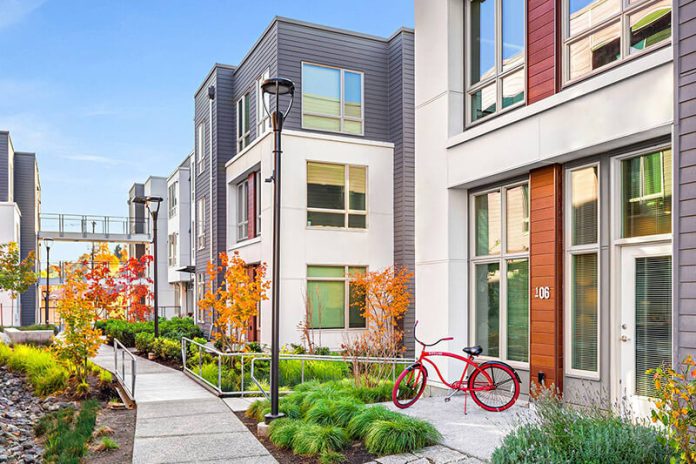On Tuesday, House Bill 1782 passed out of House Local Government Committee, but the bill was weakened in the process. Still, it’s a milestone for the bill that would push cities with at least 10,000 residents across Washington State to allow duplexes and fourplexes in place of only detached single-family homes. For a deeper dive on how the bill would work, The Urbanist covered how the original proposal would work last month.
Local Government Committee Chair Gerry Pollet (D-Seattle) and Rep. Tana Senn (D-Mercer Island) added amendments, including one lowering the sixplex requirement within a half-mile of major transit stops to a lesser fourplex requirement for cities with a population of 20,000 or more. This change also modified the measurement to be based on a walking distance instead of as the crow flies and only applies on lots exceeding 4,500 square feet. Rep. Pollet also added a section requiring jurisdictions to demonstrate transit frequency is “reasonably assured” and exempting those jurisdictions that cannot make such assurances. It’s hard to say exactly how that language will be interpreted, but has the potential to be a huge loophole for cities looking to evade the fourplex requirement. Relatedly, Pollet is a favorite of the Seattle Times Editorial Board, which has long backed exclusionary zoning, fought housing reform, and opposed affordable housing efforts like JumpStart Seattle.
In another worrisome development, the amended bill now permits cities to use an alternative minimum density plan to opt out of the fourplex requirement within the half-mile walkshed of major transit stops so long as they still hit the minimum average density threshold (now 33 dwellings per net acre) citywide. In the original proposal, sixplex zoning (or fourplex zoning for smaller cities) within a half-mile radius of major transit stops was required whether or not a city chose a minimum density plan to avoid citywide zoning changes of outside transit walksheds.
Much could change moving forward
Since the Senate is considering a companion bill, it’s possible full intent of the bill could be restored in conference committee or later in the House process. But that’s assuming both chambers pass the bill. Similar statewide zoning reforms have failed year after year, but this year the effort has the full throated support of Governor Jay Inslee and is much more concerted than in the past. In the House, 28 co-sponsors have joined lead sponsor Rep. Jessica Bateman (D-Olympia).
“While the bill is not perfect, getting it this far is a significant success that would not have been possible without your support,” Rep. Bateman tweeted after the vote. “More work is needed on the bill, but this moment is worth celebrating.”
The Urbanist has a petition with more than 1,000 signatures pushing legislator to pass statewide zoning reform and not water down measures like HB 1782. Signing this could pressure the Senate and rest of the House to undo some of the weakened provisions.
HB 1782 becomes a hybrid between competing missing middle housing bills
Other notable changes made their way into this iteration of HB 1782. For starters, like Pollet’s competing missing middle housing bill, HB 1981, is a comprehensive planning bill that addresses elements going beyond housing. As a result, its requirements will come into effect when cities adopt new comprehensive plans or major plan updates, which in most cases will delay implementation in comparison to the original bill. (Seattle’s next major comprehensive plan update is slated for 2024, for example.)
Key among these comprehensive plan requirements is the addition of a new built environment subelement that would be required of all cities planning under the Growth Management Act (GMA). This subelement would encompass goals setting around items like increasing access to open space, ensuring sufficient tree canopy to prevent urban heat island effect, and implementing measures to reduce health risks related to exposure to air pollution or other environmental contaminants. The need for the subelement is identified as arising from cities preparing for the greater urban density that could result from the bill — which feels excessive given the fact that the bill allows for only modest multi-family housing types.
Increased skepticism toward density manifests itself in other areas of the bill as well. When describing the comprehensive plans housing element, “ensuring the vitality and character of established residential neighborhoods” is listed foremost among its functions, although it does go on to require cities engage in planning to meet their projected housing needs. Another notable change is the inclusion of minimum lot sizes for required allowances on missing middle housing. For duplexes and accessory dwelling units (attached and detached) within a half-mile of major transit stops, the minimum lot size is 4,500 square feet, while for the triplexes the standard is set at corner lots of 5,000 feet or greater. Nothing in the bill, however, prevents jurisdictions from imposing density allowances that go beyond what is required.
The new transit language Pollet added that could be a loophole opportunity for cities looking to avoid the rezoning requirements is as follows: “The comprehensive plan shall describe how the city or county will ensure that the transit frequency that is relied on in the plan, development regulations, and permitting decisions is going to be continued undiminished, including any interlocal agreements with transit providers that will be utilized. For any area where such transit frequency is not reasonably assured, the level of required density or mix of housing required by this section is not required to be increased beyond what would be required if the transit was not present.” What “reasonably assured” exactly means isn’t defined, so it appears to be up to Department of Commerce to keep local jurisdictions honest.
The original bill included safe harbor from SEPA (State Environmental Protection Act) appeals. However, the new HB 1782 avoids direct SEPA protection, instead stating that missing middle housing may not be subject to permit review and environmental processes that go beyond requirements for single-family residences. In the case of Seattle, protection would be provided to developments of up to four units in single-family zones, but other cities will certainly follow different standards since no state-level guidelines exist on this point.
Like the original HB 1782, cities planning under the GMA have the option of opting out of the new requirements by instead adopting a minimum net density equivalent. Similar to HB 1981, cities selecting the minimum density requirement must “allow for an average minimum net density equivalent to 33 dwelling units per acre within a half-mile of a major transit stop, based on walking distance.” In the original version of HB 1782 that minimum net density equivalent was set at 40 dwelling units per square acre cities with populations totaling over 500,000 residents (i.e., Seattle), so the requirements for Washington State’s largest metro are scaled back here.
One interesting thing to note about where the bill stands now is that it does not adopt a tiered approach to minimum net density based on city size as the original version did, for example cities of 200,000 to 500,000 had the requirement of 30 dwelling units per acre in the original bill. This might mean that numbers may be further up for discussion in future deliberations, but if left untouched it could be bring greater density to small and mid-sized cities than what previously was floated.
Parking is another area that changes a bit in bill, although not in a way that should detract too significantly from the bill’s impacts. While parking was not required for missing middle housing development within a half-mile of major transit stops in the original HB 1782, this time around some conditions are put into place. For instance, for cities of 100,000 residents or more, parking cannot be required within a half-mile of a major transit stop unless there is no on-street parking on the street of the project site. Additionally, cities with populations of 20,000 to 100,000 can require the construction of one parking space for every three bedrooms on the lot, even in areas within a half-mile of major transit stops.
When introducing his legislation, Pollet voiced several concerns about how “communities of interest” (i.e., homeowner associations and neighborhoods organized under covenants) could enact rules that would impede the development of missing middle housing. This bill contains language explicitly outlawing that. It also requires that anti-displacement measures be enacted in these communities. However, the bill mostly falls on the side of the original HB 1782 in its treatment of displacement prevention and planning for affordability, notably by veering away from HB 1981’s steep requirement that one out of every four units of new housing be affordable or contribute to an affordable housing fund.
In what might be intended to facilitate the creation of single-family home on small lots, the bill allows for cities with a population over 40,000 to subdivide lots to 3,200 square feet or 80% of the average lot on a block. This is presented as a means by which to increase the “supply of housing affordable to lower and moderate-income residents.” So while the affordable single-family “starter house” on a small lot has disappeared like unicorns into legend, it lives on in this bill. One bright spot, however, is that the bill does allowed for detached accessory units (DADUs) to be sold separately from the primary development on a lot.

One last notable change is the addition of the final section of the bill, which states: “If specific funding for the purposes of this act, referencing this act by bill or chapter number, is not provided by June 30, 2022, in the omnibus appropriations act, this act is null and void.” While Governor Jay Inslee has included funding for the HB 1782 implementation in his proposed biennial budget, no such drop dead date for funding was included in the bill’s original version.
Sign our Homes4WA petition here.
This article was updated at 7:45pm to note the change to the minimum density plans.





